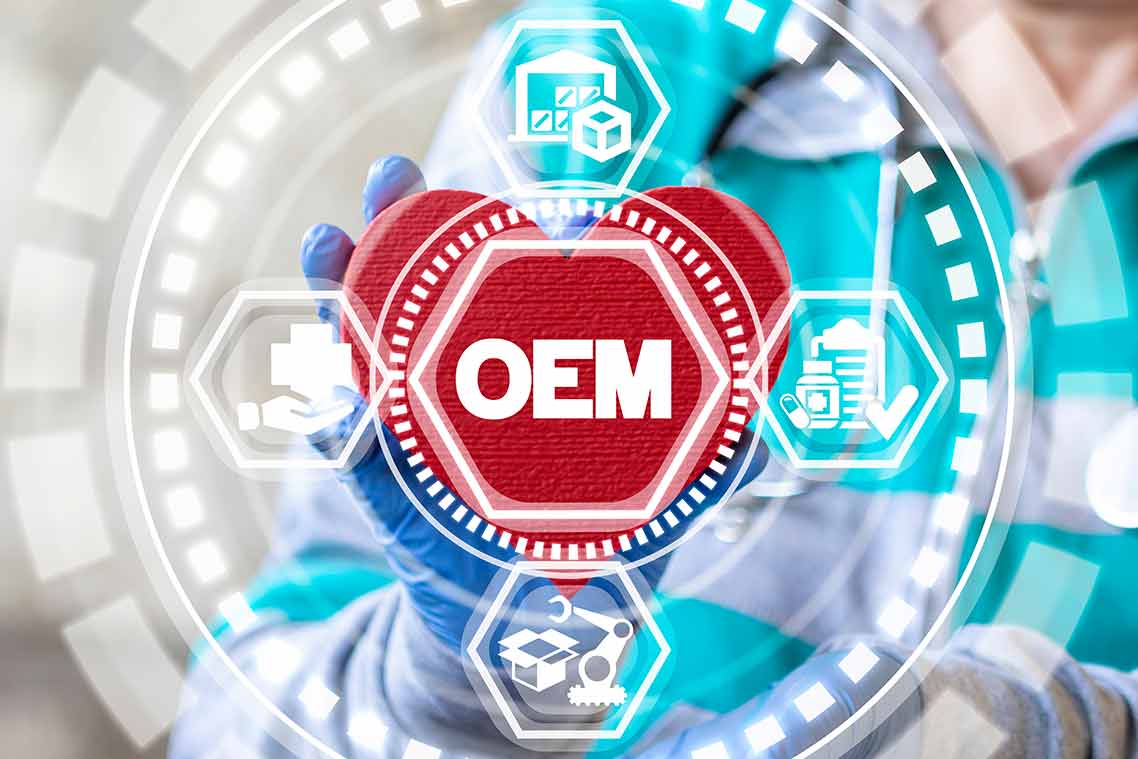In today’s fast-paced technological world, acronyms and industry jargon are abundant. One such term that often surfaces in discussions related to manufacturing and production is “OEM.” But what exactly does OEM mean? This article aims to demystify this commonly used acronym, providing a comprehensive understanding of its definition, significance, and widespread applications.
OEM stands for Original Equipment Manufacturer. It refers to a company or entity that produces parts, components, or complete products that are then used by another company (known as the “brand” or “end-user”) in their final product offerings. In simpler terms, an OEM is responsible for designing and manufacturing parts that are incorporated into finished products under someone else’s brand name.
Defining OEM and its importance in business
OEM stands for Original Equipment Manufacturer. It refers to a company that produces components or products that are used by another company as part of its own product offering. In other words, an OEM manufactures parts or products that are then branded and sold by another company.
The importance of OEM in business lies in the advantages it offers to both parties involved. For the OEM, it provides a steady source of revenue as they can focus on their core competency of manufacturing while relying on other companies to handle marketing and distribution. This allows them to achieve economies of scale and reduce costs. On the other hand, for the company utilizing OEM services, it enables them to bring products to market quickly without having to invest heavily in manufacturing infrastructure or expertise. They can leverage the specialized skills and capabilities of the OEM to deliver high-quality products under their own brand name.
Furthermore, OEM relationships promote innovation and collaboration between companies. By working closely together, both parties can share knowledge, insights, and technologies that lead to improved product design and development. This collaborative approach fosters long-term partnerships built on trust and mutual benefit. The benefits include cost savings, speed-to-market advantages, and access to expertise that ultimately contribute to the success and growth of businesses operating within various industries.
History: Origins and evolution of OEM
OEM, or Original Equipment Manufacturer, refers to a company that manufactures products or components that are used in another company’s end product. The concept of OEM is not a recent development but has its roots in early manufacturing practices. In the early days, companies would often produce all the components needed for their final product in-house. However, as industries grew and became more specialized, it became more efficient to outsource certain components to other manufacturers who were experts in those specific areas.
The origins of OEM can be traced back to the Industrial Revolution when mass production techniques started gaining popularity. With the rise of factories and assembly lines, companies began focusing on producing specific parts rather than entire products. This led to the emergence of specialized manufacturers that supplied these parts to different companies for integration into their final products.
Today, OEM plays a crucial role across various industries such as automotive, electronics, aerospace, and telecommunications. It allows companies to leverage specialized expertise while maintaining cost-effectiveness by outsourcing certain aspects of production. Additionally, it enables faster time-to-market for new products through collaborations between original equipment manufacturers and companies requiring their components.
Applications: How OEM is used across different sectors
OEM, or Original Equipment Manufacturer, is a term widely used in various sectors to describe the process of manufacturing products that are then sold under another company’s brand name. This practice is prevalent in industries such as automotive, electronics, and healthcare, among others. In the automotive sector, OEM is commonly used when referring to the production of parts and components for vehicles by specialized manufacturers. These parts are then assembled by automobile companies to create the final product.
In the electronics industry, OEM refers to companies that design and manufacture electronic devices and components which are later rebranded by other companies or sold as generic products. This allows businesses to focus on their core competencies without having to invest heavily in manufacturing capabilities. Moreover, in the healthcare sector, OEM is utilized for medical devices such as pacemakers or imaging equipment. Medical device manufacturers work closely with healthcare providers and institutions to produce customized solutions based on specific requirements. Overall, OEM plays a crucial role across different sectors by enabling companies to leverage specialized expertise while maintaining control over branding and distribution channels. It provides cost-effective solutions and fosters innovation within these industries while ensuring high-quality products reach end consumers efficiently.
Benefits of OEM partnerships
OEM (Original Equipment Manufacturer) partnerships offer numerous advantages to both parties involved. Firstly, these collaborations allow OEM partners to leverage each other’s expertise and resources, resulting in improved product quality and innovation. By combining their strengths, OEMs can develop cutting-edge technologies that surpass what either party could achieve individually. Secondly, forming an OEM partnership enables companies to expand their market reach and increase customer satisfaction. Through the collaboration, OEMs can tap into new geographical regions or target different customer segments that were previously inaccessible. This expanded market presence helps drive sales growth and enhances brand recognition for both partners.
Lastly, OEM partnerships often lead to cost efficiencies and streamlined operations for all involved parties. By sharing production facilities, supply chains, or R&D investments, companies can reduce costs while maintaining high-quality standards. Additionally, these collaborations foster knowledge exchange between partners which can result in process improvements and increased productivity. The benefits include enhanced product quality and innovation capabilities, expanded market reach, increased customer satisfaction, cost efficiencies through shared resources and streamlined operations.
Challenges in the OEM industry
Original Equipment Manufacturer (OEM) refers to a company that produces parts or components used in the production of another company’s end product. In the manufacturing industry, OEMs play a critical role by providing specialized parts and technologies that are integrated into various products such as automobiles, electronics, appliances, and more. However, despite their importance, OEMs face several challenges that can impact their operations and profitability.
One major challenge faced by OEMs is intense competition. The market for OEM parts is highly competitive, with numerous companies vying for contracts from manufacturers across different industries. This competition drives OEMs to constantly innovate and improve their products to stay ahead of rivals. Additionally, pricing pressure from customers can also be a significant challenge for OEMs. Manufacturers often demand lower prices from their suppliers in order to reduce costs and increase their own profit margins.
Another challenge in the OEM industry is maintaining quality standards while meeting increasing demand. As manufacturers rely on OEMs for crucial components or technology, any delays or quality issues can have significant consequences on the production line. OEMs must ensure strict quality control measures are in place to meet customer expectations consistently.
Examples of successful OEM collaborations
OEM, or Original Equipment Manufacturer, refers to a company that produces components or products that are used in another company’s end product. OEM collaborations have become increasingly common in various industries as they offer numerous benefits for both parties involved. One notable example of a successful OEM collaboration is the partnership between Apple and Intel. Apple has been using Intel processors in its Mac computers since 2006, which has helped enhance the overall performance and capabilities of their devices. This collaboration has allowed Apple to leverage Intel’s technological expertise while enabling Intel to tap into a vast consumer base through Apple’s popular products.
Another noteworthy example of a successful OEM collaboration is the partnership between Nike and Gore-Tex. Nike integrated Gore-Tex’s waterproof and breathable fabric technology into their athletic footwear and apparel lines. This collaboration has allowed Nike to provide customers with high-performance gear suitable for various weather conditions while benefiting from Gore-Tex’s reputation as a leader in outdoor fabric technology. By aligning their respective strengths, Nike was able to expand its product range and capture new market segments, while Gore-Tex gained wider exposure by collaborating with a globally recognized sports brand.
Overall, successful OEM collaborations like these demonstrate how partnering with complementary companies can lead to mutually beneficial outcomes by leveraging each other’s strengths and resources.
Future trends: Emerging developments in the OEM landscape
OEM, or Original Equipment Manufacturer, refers to a company that manufactures products and components that are used in another company’s end product. In the context of the blog subtopic “Future trends: Emerging developments in the OEM landscape,” it focuses on discussing the upcoming trends and advancements in this sector.
One emerging development is the increasing adoption of smart manufacturing technologies by OEMs. With advancements in Internet of Things (IoT) and artificial intelligence (AI), OEMs are integrating intelligent systems into their production processes. This allows for real-time monitoring, predictive maintenance, and improved overall efficiency. Smart manufacturing enables OEMs to optimize their operations, reduce costs, and deliver high-quality products.
Another trend worth noting is the growing emphasis on sustainability within the OEM industry. As environmental concerns continue to escalate, there is a rising demand for eco-friendly products and practices. OEMs are now working towards developing sustainable solutions by incorporating renewable materials, energy-efficient processes, and recycling initiatives into their manufacturing processes. This shift towards sustainability not only aligns with global environmental goals but also helps OEMs meet consumer expectations for more responsible and ethical products.
Conclusion: The future of OEM
In conclusion, OEM stands for Original Equipment Manufacturer and refers to a company that produces components or products that are used by another company in their final product. These OEMs play a crucial role in the supply chain and contribute to the overall quality and performance of the end product. By partnering with OEMs, companies can benefit from their specialized expertise and resources, allowing them to focus on their core competencies. Furthermore, OEMs often offer cost-effective solutions due to economies of scale and efficient manufacturing processes. Therefore, it is essential for businesses to understand the significance of OEM partnerships and leverage them strategically to gain a competitive edge in the market.






Be First to Comment